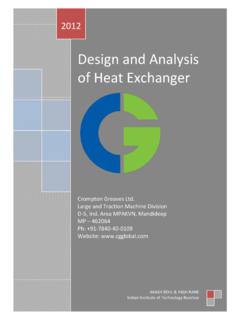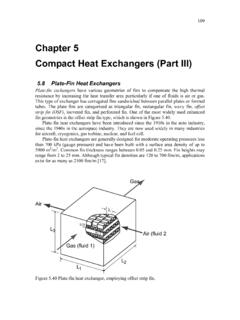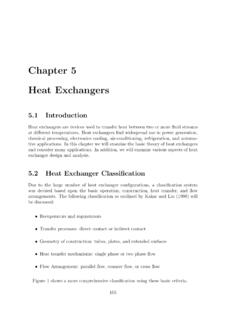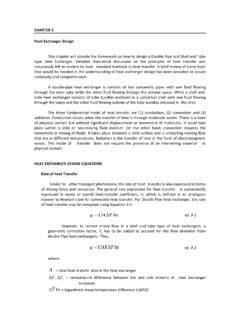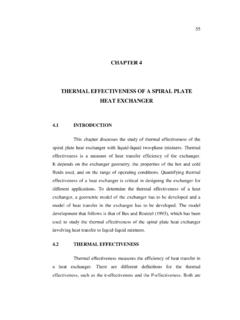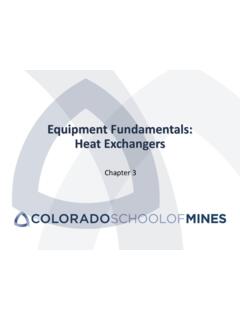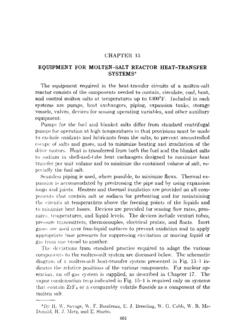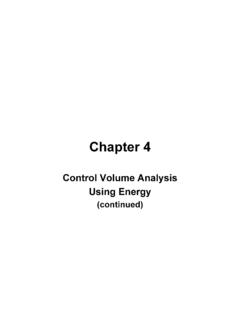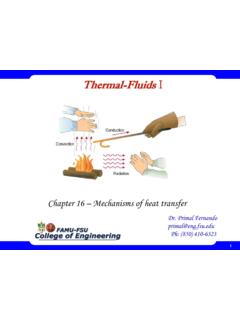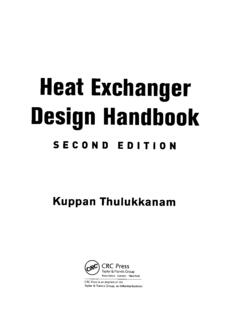Transcription of SCHAUM'S OUTLINE OF THEORY AND PROBLEMS OF HEAT …
1 SCHAUM S OUTLINE OF THEORY AND PROBLEMS OF heat transfer second Edition DONALD R. PITTS, Professor Emeritus of Mechanical and Aerospace Engineering and Engineering Science The University of Tennesse -Knoxville LEIGHTON E, SISSOM, , Dean Emeritus of Engineering Tennessee Technological Universit4, -Cookeville SCHAUM S OUTLINE SERIES McGRAW-HILL New York San Francisco Washington, Auckland Bogotlf Caracas Lisbon London Madrid Mexico City Milan Montreal New Delhi San Juan Singapore Sydney Tokyo Toronto Dr. DONALD R. PITTS holds three engineering degrees- the from Auburn University, the , and from the Georgia Institute of Technology. His 27 years of academic experiences include appointments at Tennessee Technological University, Clemson University, and the University of Tennessee-Knoxville. All of his university assignments have been in teaching and research in the Thermal Sciences (Thermodynamics, Fluid Mechanics, and heat transfer ).
2 These ex-periences include one year as a Program Manager at NSF and one year as Director, Tennessee Energy Extension Service. Dr. Pitts has coauthored one major textbook and one Schaum s OUTLINE , both in the heat transfer /fluid mechanics area. He has authored or coauthored 20 refereed research papers and major reports, and he is thoroughly qualified to write on the topic of heat transfer . Dr. LEIGHTON E. SISSOM is a registered professional engineer. He holds four degrees, including a from Tennessee Technological University and from the Georgia Institute of Technol-ogy. He has served as a consultant to over 600 organizations in 41 states and 11 foreign countries. He has written many papers and proprietary reports, and has coauthored four books including one textbook and one Schaum s OUTLINE . His 30 years in academe have been focused on teaching and research in the thermal sciences (Thermal Dynamics, Fluid Mechanics, and heat transfer ).
3 Dr. Sissom is highly qualified to write on the subject of heat transfer . Schaum s OUTLINE of THEORY and PROBLEMS of heat transfer Copyright 01998, 1977 by The McGraw-Hill Companies, Inc. All rights reserved. Printed in the United States of America. Except as permitted under the Copyright Act of 1976, no part of this publication may be reproduced or distributed in any forms or by any means, or stored in a data base or retrieval system, without the prior written permission of the publisher. 2 3 4 5 6 7 8 1 I0 11 12 I3 14 15 I6 17 IX 19 20 PRS PRS 9 0 2 1 0 9 ISBN 0-07-050207-2 Sponsoring Editor: Barbara Gilson Production Supervisor: Sherri Souffrance Editing Supervisor: Maureen B. Walker Project Supervision: Keyword Publishing Services Ltd Library of Congress Cataloging-in-Publication Data Pitts, Donald R. Schaum s OUTLINE of heat transfer / Donald R. Pitts, Leighton E. Sissom. -2nd ed. p. cm. -(Schaum s OUTLINE series) Originally published: Schaum s OUTLINE of THEORY and PROBLEMS of heat transfer .
4 New York : McGraw-Hill, cl997. Includes index. ISBN 0-07-OSO207-2 (pbk.) 1. heat -Transmission. 2. heat -Transmission - PROBLEMS , exercises, etc. I. Pitts, Donald K.,Schaum s OUTLINE of THEORY and PROBLEMS of heat transfer . 11. Sissom, Leighton E. 111. Title. IV. Series. 1988 2-dc21 98-21008 CIP McGraw-Hill i?? A Division of Companies Preface Like the first edition, as well as all of the Schaum s Series books, this second edition of heat transfer is intended to function as (1)an independent, self-teaching text and/or (2) a supplemental aid for students taking a college course in heat transfer at the junior or senior level. To fulfil1 these dual roles, there are several factors that must be considered. One of these is the long-standing argument over the nature of treatment, that is, mathematical derivations of the thermal transport rate equations or collections and applications of empirical equations. Again, as in the first edition, we believe we have achieved a useful compromise between these two approaches.
5 Another major factor is the choice of a unit system. The unit system must be compatible with that in current college textbooks on this subject. Many, if not most, heat transfer texts are using the Systkme International d Unit6s (SI unit system) exclusively. The ASME has required that all publications of the Society since July 1, 1974, must be in SI units. However, the slow transition from the English system of units decrees that most students currently studying heat transfer will need to be familiar with both SI and English units for many more years. In this book we have 208 solved PROBLEMS having units and 63 solved PROBLEMS with no units. The percentage split between SI and English units is approximately 75/25 whereas the first edition had approximately 60/40 English/SI PROBLEMS . But we have included enough English unit system solved PROBLEMS to satisfy the needs of students and professionals using English units only or those needing a dual system experience.
6 In support of this need a very useful approach to obtaining property values has been incorporated. Basically, we have included rather complete tables for both SI and English units. The English tables continue to feature conversion factors at the bottom of each page. While the field of heat transfer is constantly growing in useful knowledge, we have intentionally emphasized the more traditional and familiar approaches to each of the major subtopics of this subject. In many areas, we note that newer empirical correlations yield very nearly the same results as do the older ones. We have utilized simpler approaches wherever suitable. As in the first edition we have continued the approach where each chapter begins with a statement of the class of heat transfer , or related topics to be considered. This is followed by abbreviated textual treatment@), mathematical and/or empirical. Then the focus turns quickly to the Solved PROBLEMS which are the very essence of the presentation.
7 Note that related topics include Fluid Mechanics-Chapter 5. Although not in most heat transfer texts, this book will be used by many persons with no background in Fluid Mechanics. This subject is very important, indeed, essential to understanding the material in Chapters 6, 7, and 8, and to a lesser extent, Chapter 10. In summary, for each chapter we (i) present a concise textual treatment of a major subtopic emphasizing THEORY , analyses and empiricism important to that subject, (ii) provide an extensive set of Solved PROBLEMS , practical and theoretical, including a mixture of unit systems with unit inclusion in many PROBLEMS , and finally (iii) include a set of unworked, Supplementary PROBLEMS (usually with answers) to enhance opportunities for self evaluation.. 111 iv PREFACE We believe that this second edition meets the changing needs for a self- teaching text for working professionals and students in this field and the need for a supplemental aid for junior- and senior-year college students.
8 We wish every user a fulfilling experience in study from this book. We wish to express our appreciation of the efforts of Ms. Mary Loebig Giles of McGraw-Hill for her continued support of this project, and to Ms. Janine Jennings who typed the manuscript. Knoxville, TN LEIGHTONE. SISSOM Cookeville, TN Contents Chapter 1 INTRODUCTION .. 1 Conduction .. i Convection .. 1 Radiation .. 2 Material Properties .. 2 Units .. 5 Chapter 2 0N E .D IM E NS I0N A L ST EA DY- STAT E C 0N D U CTI 0N .. 16 Introductory Remarks .. 16 General Conductive Energy Equation .. 16 Plane Wall: Fixed Surface Temperatures .. 18 Radial Systems: Fixed Surface Temperatures .. 19 Plane Wall: Variable Thermal Conductivity .. 20 heat Generation Systems .. 20 Convective Boundary Conditions .. 22 heat transfer from Fins .. 25 Chapter 3 MULTIDIMENSIONAL STEADY-STATE CONDUCTION .. 56 Introduction .. 56 Analytical Solutions.
9 56 Conductive Shape Factor .. 59 Numerical Analysis .. 61 Chapter 4 TIME-VARYING CONDUCTION .. 87 Introduction .. 87 Biot and Fourier Moduli .. 87 Lumped Analysis .. 88 One-Dimensional Systems: Fixed Surface Temperature .. 89 One-Dimensional Systems: Convective Boundary Conditions .. 91 Chart Solutions: Convective Boundary Conditions .. 92 Multidimensional Systems .. 98 Numerical Analysis .. 99 Chapter 5 FLUID MECHANICS .. 123 Fluid Statics .. 123 Fluid Dynamics .. 124 Conservation of Mass .. 127 Equation of Motion Along a Streamline .. 128 Conservation of Energy .. 129 Chapter 6 FORCED CONVECTION: LAMINAR FLOW .. 144 Hydrodynamic (Isothermal) Boundary Layer: Flat Plate .. 144 V vi CONTENTS Thermal Boundary Layer: Flat Plate .. 149 Isothermal Pipe Flow .. 151 heat transfer in Pipe Flow .. 154 Summary of Temperatures for Property Evaluations .. 157 ~~ ~ Chapter 7 FORCED CONVECTION: TURBULENT FLOW.
10 184 Equations of Motion .. 184 heat transfer and Skin Friction: Reynolds Analogy .. 187 Flow over a Flat Plate .. 187 Flow in Pipes .. 190 External Flow over Submerged Bodies .. 195 heat transfer to Liquid Metals .. 200 ~ Chapter 8 NATURAL CONVECTION .. 221 Vertical Flat Plate .. 221 Empirical Correlations: Isothermal Surfaces .. 226 Free Convection in Enclosed Spaces .. 227 Mixed Free and Forced Convection .. 231 Newer Correlations .. 232 ~~ Chapter 9 BOILING AND CONDENSATION .. 245 Boiling Phenomena .. 245 Pool Boiling .. 246 Flow (Convection) Boiling .. 249 Condensation .. 251 ~~~ ~ ~ Chapter 10 heat EXCHANGERS .. 268 Types of heat Exchanger .. 268 heat transfer Calculations .. 270 heat Exchanger Effectiveness (NTU Method) .. 274 Fouling Factors .. 275 Chapter 11 RADIATION .. 289 Introduction .. 289 Properties and Definitions .. 289 Blackbody Radiation.
